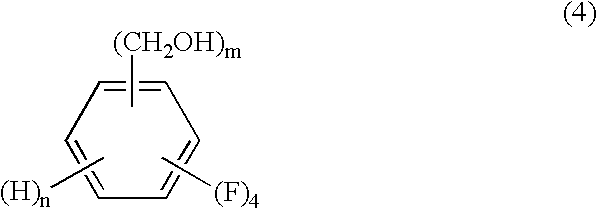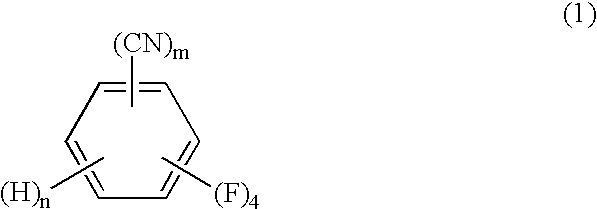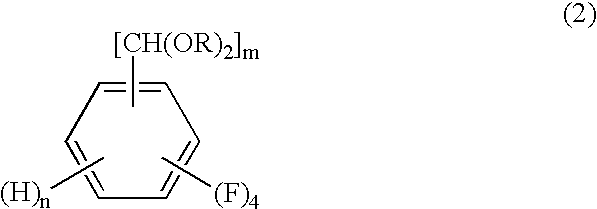Process for producing tetrafluorobenzenemethanols
a technology of tetrafluorobenzenemethanol and tetrafluorobenzenemethanol, which is applied in the preparation of carbonyl compounds, physical/chemical process catalysts, organic chemistry, etc., can solve the problems of low yield, low purity of products, and inability to achieve industrially advantageous methods, etc., and achieve high purity and high yield
- Summary
- Abstract
- Description
- Claims
- Application Information
AI Technical Summary
Benefits of technology
Problems solved by technology
Method used
Image
Examples
example 1
Preparation of 2,3,5,6-Tetrafluorobenzaldehyde Dimethylacetal
##STR17##
To a 50 ml-volume glass-made reactor equipped with a condenser tube, 0.50 g of sponge nickel thoroughly replaced by methanol was added and then a mixed solution containing 3.53 g of 2,3,5,6-tetrafluorobenzonitrile, 4.08 g of 97% sulfuric acid and 19.78 g of methanol was added. After the vapor phase moiety was thoroughly purged with hydrogen gas, a balloon charged with hydrogen gas was fixed to the top of the condenser tube and the solution was stirred at 10.degree. C. for 6 hours. The reaction solution was analyzed by gas chromatography and the conversion of 2,3,5,6-tetrafluorobenzonitrile was found to be 65.9%. Subsequently, the solution was stirred at 25.degree. C. overnight. Then, the conversion was 100%. From this reaction solution, the catalyst was filtered and after heating the filtrate at 60.degree. C. for 2 hours, the methanol was distilled off. The residue was cooled to room temperature and 2.09 g of an o...
example 2
Preparation of 2,3,5,6-Tetrafluorobenzaldehyde
##STR18##
To a 200 ml-volume glass-made reactor equipped with a condenser tube, 2.09 g of 97% 2,3,5,6-tetrafluorobenzaldehyde dimethylacetal was added and subsequently 25.29 g of water and 45.72 g of 97% sulfuric acid were added. The mixture solution was stirred at 25.degree. C. for 1 hour and thereafter, 100 ml of methylene chloride was added to separate the organic layer. The methylene chloride was distilled off by a rotary evaporator and the residue was cooled to obtain 1.67 g of crystal. The crystal was analyzed by means of a gas chromatograph as an internal standard method using o-dichlorobenzene and this compound was found to be 2,3,5,6-tetrafluorobenzaldehyde having a purity of 99.8%. The yield of 2,3,5,6-tetrafluorobenzaldehyde produced from 2,3,5,6-tetrafluorobenzaldehyde dimethylacetal was 99.6%.
example 3
Preparation of 2,3,5,6-Tetrafluorobenzaldehyde
##STR19##
Into a 1 L-volume glass-made reactor equipped with a condenser tube, 127.08 g of 2,3,5,6-tetrafluorobenzonitrile and 120.00 g of methanol were charged. While stirring the mixture in a water bath, a mixed solution containing 228.48 g of methanol and 146.88 g of 97% sulfuric acid was added dropwise. Subsequently, 9.33 g of sponge nickel thoroughly replaced with methanol was added, the vapor phase moiety was thoroughly purged with hydrogen gas, and then the solution was stirred at 20.degree. C. for 6 hours under atmospheric pressure in a hydrogen atmosphere. The reaction solution was analyzed by means of a gas chromatograph and it was found that 2,3,5,6-tetrafluorobenzonitrile completely disappeared. Thereafter, the vapor phase moiety was purged with nitrogen gas and the solution was stirred at 60.degree. C. for 3 hours. The resulting reaction solution was analyzed by means of a gas chromatograph and it was confirmed that 2,3,5,6-t...
PUM
| Property | Measurement | Unit |
|---|---|---|
| mass % | aaaaa | aaaaa |
| temperature | aaaaa | aaaaa |
| temperature | aaaaa | aaaaa |
Abstract
Description
Claims
Application Information
 Login to View More
Login to View More - R&D
- Intellectual Property
- Life Sciences
- Materials
- Tech Scout
- Unparalleled Data Quality
- Higher Quality Content
- 60% Fewer Hallucinations
Browse by: Latest US Patents, China's latest patents, Technical Efficacy Thesaurus, Application Domain, Technology Topic, Popular Technical Reports.
© 2025 PatSnap. All rights reserved.Legal|Privacy policy|Modern Slavery Act Transparency Statement|Sitemap|About US| Contact US: help@patsnap.com



